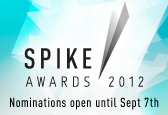
Once again, our friends at Kalypso have issued a challenge for all of you product development companies out there… actually, two challenges this time. 1. Move past the myths that keep you from using social models and tools to support innovation and 2. If you have moved past these myths, nominate yourselves for a SPIKE Award! Read on for some great insight from Amy about three social product innovation hang-ups you need to get over.
Despite the value companies can achieve using social models and tools to support the innovation and product development processes, the typical, negative knee-jerk reaction when someone says “social” and “product development” in the same sentence is still alive and well. Here are some of the top hang-ups we hear, and some very good reasons why you should get over them, soon.
Hang-up #1: We’re Not Going to Use Facebook to Design our Next Product
That’s right, you’re not. Companies with this hang-up only think about social product innovation from the angle of using common social media platforms to do product development. But that’s not what it’s really about. The real goal is to augment traditional product development tools with social capabilities, to help make development faster, easier and more secure (yup, more secure – but I’ll come back to that later).
Instead of assuming that “social” equals Facebook, companies should consider how some of the social concepts Facebook has made popular can apply in an internal product development setting. A recent blog post in DesignNews, “Product Development Gets Social,” points out that “Things like activity feeds (akin to a Facebook news feed) can keep people who are connected to a project up to date on status or design changes. Microblogging (along the lines of tweets) can be a short, targeted way to provide status updates or ask for feedback.” The collaborative possibilities are huge! Think about the ability to create communities around specific parts and products, where engineers from multiple locations can work together, ask questions, share knowledge, and brainstorm.
Most companies have made big investments to put sophisticated computer aided design (CAD), product lifecycle management (PLM), and product portfolio management (PPM) tools in place to do important, specialized product development work. Generic social platforms like Facebook are not helpful here. But incorporating social capabilities into these platforms can help turn the voice of the customer into ideas, and ideas into products and enhancements that hit the market at the right time and cost.
Hang-up #2: This Isn’t for Me – Only B2C Companies Can Benefit
It’s certainly true that in a business to consumer (B2C) environment, companies can use social tools to get ideas and suggestions for the next beverage flavor, sneaker color or candle scent. And they can use very public platforms, including Facebook, to do it really well. But this doesn’t mean there’s no upside for companies that make cars, medical devices, chemicals, pharmaceuticals or high tech devices.
This hang-up is similar to the first one since it has to do with our own consumer bias. We’re all consumers, so we can easily understand the benefit to companies that we freely give our ideas and suggestions to. But what if your company makes products for other companies (B2B), or your product requires your development team to be actual rocket scientists?
The challenges are different, but that doesn’t mean social product innovation has no place in your product development process. As Jim Brown of Tech-Clarity is known for saying, “product development is inherently social.” Whether your company has 100 or 100,000 engineers, a single design center or 1,000 global locations, communication and collaboration are undoubtedly an ongoing challenge. Incorporating intuitive social tools on top of design tools already in place can make communication faster, easier and more intuitive.
Hang-up #3: If It’s Social, It’s Not Secure
We are all well aware that “what happens on Facebook lives forever.” Your friends, family and employers have easy access to your vacation pics and what you ate for breakfast this morning. But remember hang-up #1? We’re not talking about Facebook here. Deep breath.
Product development is becoming increasingly global. We work not only across time zones and countries with other people from our own companies, but also with suppliers and partners around the world. Think for a minute about how these teams are sharing information and collaborating today. Sending emails? Spending hours on conference calls? Using FTP or DropBox to share sensitive design files or product information?
Here’s a sad truth. You probably have very nice, formal processes established for sharing information and data, but your people may not have the time or patience to follow these processes. It’s all about instant gratification and quick answers, so you can bet they develop their own work-arounds to overcome processes they consider cumbersome or time consuming.
Emails can easily be forwarded into the wrong hands and file sharing apps can be hacked, meaning your sensitive product information may not be as secure as you thought. Adding a social capabilities to your PLM or PPM implementations means they use the same security settings. So even when a design environment is opened up to contributors from different companies, your intellectual property is safe.
And consider the sensitive conversations taking place in the thousands of emails your product design teams send back and forth daily. How can an important email discussion be saved and kept in context with the product it pertains to? Capture those conversations in a social tool that associates it with that product. How can design teams avoid confusion with countless separate email conversations going on simultaneously? Use a social tool to make the conversation securely available to that product team, so they can easily see the entire dialogue and make their own contributions.
Getting Past the Hang-ups

Despite the persistent myths, there are many great examples of companies that have seen strong success augmenting their product development and innovation processes with social tools and processes. Many of them have won SPIKE Awards for their efforts. Sound like something you’re doing? Nominations for 2012 SPIKE Awards are being accepted now through September 7th!
We appreciate these tips from Kalypso. If you’re intrigued, it is worth a revisit to one of our most popular blog posts from Patrick Tickle: “Facebook for the Enterprise – Is Real Collaboration Finally Here?,” which discusses the concept and purpose of Enterprise Social Networking.
We’d like to hear from you. Do you use social media to augment product development and innovation processes and promote collaboration among stakeholders? Why or why not? Share your experiences by leaving a comment below.



